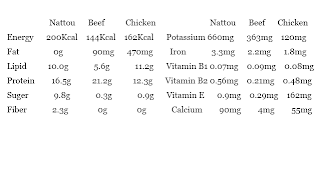
Nattou, Mystery Food!
Nattou, Mystery Food!
Fermented Soybeans, known as 'Nattou' in Japan, have been eaten for more than 10,000 years and represent an important part of traditional Japanese cuisine.Nattou is traditionally served as part of the Japanese breakfast, which as well as nattou, also consists of rice and miso soup - this is the established style of eating in Japan since the Edo period (1603~). Nattou has since become very well known in Japan for it's abundant health benefits and high nutritional value.
During the Taisho period (1913~), Professors at Hokkaido University researched the many health benefits of nattou, and assisted in producing basic guidelines for the correct fermentation of the soybeans to ensure the highest nutritional value when served. This research laid the foundation for the development of fermented soybeans, nattou, as we know it today.
"Nattou's packed full of vitamins, minerals, natural fibres and protein"
The annual consumption of nattou in 1996, added up to the value of over 160 billion yen in Japan. Regionally speaking, Tokyo is the largest consumer of nattou, followed by Kanagawa and Hokkaido. Nattou tends to be consumed more on the east side of Japan than on the west, due to the fact that in ancient times nattou was eaten in place of fish and vegetables due to the colder weather conditions compared to the west side, where people had an abundance of other foods available to them.
Nattou is extremely low in fat and rich in nutrients. It is also packed full of vitamins, minerals, natural fibres and protein, making it popular as part of a healthy diet, and suitable for people looking for a healthy way to lose weight and remain in good shape.As well as the known nutritional benefits of nattou (see table below), it has also been discovered that nattou has the ability to dissolve blood clots and fight disease-causing germs such as E. coli bacteria 0-157. Research also continues after signs that it may have a positive effect on cancer.
Here is a break-down of nattou's nutritional content per a 100g serving, in comparison to other common alternatives such as Beef or Chicken:
Nattou, Mystery Food!
Fermented Soybeans, known as 'Nattou' in Japan, have been eaten for more than 10,000 years and represent an important part of traditional Japanese cuisine.Nattou is traditionally served as part of the Japanese breakfast, which as well as nattou, also consists of rice and miso soup - this is the established style of eating in Japan since the Edo period (1603~). Nattou has since become very well known in Japan for it's abundant health benefits and high nutritional value.
During the Taisho period (1913~), Professors at Hokkaido University researched the many health benefits of nattou, and assisted in producing basic guidelines for the correct fermentation of the soybeans to ensure the highest nutritional value when served. This research laid the foundation for the development of fermented soybeans, nattou, as we know it today.
"Nattou's packed full of vitamins, minerals, natural fibres and protein"
The annual consumption of nattou in 1996, added up to the value of over 160 billion yen in Japan. Regionally speaking, Tokyo is the largest consumer of nattou, followed by Kanagawa and Hokkaido. Nattou tends to be consumed more on the east side of Japan than on the west, due to the fact that in ancient times nattou was eaten in place of fish and vegetables due to the colder weather conditions compared to the west side, where people had an abundance of other foods available to them.
Nattou is extremely low in fat and rich in nutrients. It is also packed full of vitamins, minerals, natural fibres and protein, making it popular as part of a healthy diet, and suitable for people looking for a healthy way to lose weight and remain in good shape.As well as the known nutritional benefits of nattou (see table below), it has also been discovered that nattou has the ability to dissolve blood clots and fight disease-causing germs such as E. coli bacteria 0-157. Research also continues after signs that it may have a positive effect on cancer.
Here is a break-down of nattou's nutritional content per a 100g serving, in comparison to other common alternatives such as Beef or Chicken:

Nattou is usually eaten with soy-sauce, but there are also many other ingredients, as mentioned below, that can be combined with nattou to produce different tastes and boost nutritional values.
Mustard - Adds flavour and works as a form of sterilization for the nattou.
Spring onion - Increases the flavour of nattou and improves the absorption of vitamin B2.
Egg - Makes a good combination for mild flavour and balanced essential amino acids, vitamins A, B2, D, and iron.
Garlic - Lightly grated and mixed in with the nattou, it is well known to help recover the body when run-down or tired, and helps the metabolism.
Apple - Lightly grated and mixed in with the nattou, it adds a more sour taste, and also helps to recover the body from fatigue, reduce blood pressure, and act against diarrhoea and constipation.
Cheese or Mayonnaise - If you wish to reduce the characteristic smell of nattou, or to make the taste milder, you can add a little cheese or mayonnaise.
Mustard - Adds flavour and works as a form of sterilization for the nattou.
Spring onion - Increases the flavour of nattou and improves the absorption of vitamin B2.
Egg - Makes a good combination for mild flavour and balanced essential amino acids, vitamins A, B2, D, and iron.
Garlic - Lightly grated and mixed in with the nattou, it is well known to help recover the body when run-down or tired, and helps the metabolism.
Apple - Lightly grated and mixed in with the nattou, it adds a more sour taste, and also helps to recover the body from fatigue, reduce blood pressure, and act against diarrhoea and constipation.
Cheese or Mayonnaise - If you wish to reduce the characteristic smell of nattou, or to make the taste milder, you can add a little cheese or mayonnaise.
ဒါကေတာ့ tokyocube.com မွာ ေဖာ္ျပထားတဲ့ ဂ်ပန္ပဲပုတ္ေစ့ရဲ႕အာဟာရတန္ဘုိးမ်ားအေၾကာင္းျဖစ္ပါတယ္။
ဂ်ပန္နတ္တုိးနဲ႔ ရွမ္းျပည္ပဲပုတ္ေစ့ အရသာခ်င္းအတူတူပါဘဲ။ မတူတာက ဂ်ပန္ပဲပုတ္ကခၽြဲက်ိတဲ့အမွ်င္ေတြပါျပီး ရွမ္းပဲပုတ္က အမွ်င္မပါပါ။ ကၽြန္ေတာ္တုိ႔ဆီမွာ ပဲပုတ္ကုိ ၾကက္သြန္နီ ခရမ္းခ်ဥ္သီးတုိ႔နဲ႔ခ်က္ျပီး တုိ႔စရာ အသီးအႏွံ အရြက္စတာေတြနဲ႔ တြဲဘက္စားေလ့ရွိပါတယ္။ ဂ်ပန္မွာေတာ့ နတ္တုိးကုိ တစ္ခါသုံးဘူးေလးေတြနဲ႔ ထည့္ေရာင္းျပီး အသင့္စားႏုိင္ေအာင္ ပဲငံျပာရည္အိတ္ကေလးအတူပါျပီးသားမုိ႔ ေရာေမႊျပီးစားယုံပါဘဲ။ ၃ဘူးတဲြကုိ ၆၈ ယန္းနဲ႔ေရာင္းပါတယ္။ တုိက်ဳိဘက္ကဂ်ပန္ေတာ္ေတာ္မ်ားမ်ားက နတ္တုိးနဲ႔ ၾကက္ဥအစိမ္းကုိ ေရာသမျပီး ထမင္းေပၚဆမ္းလုိ႔ နံနက္စာအျဖစ္စားေလ့ရွိပါတယ္။ ႏုိရိလုိ႔ေခၚတဲ့ ေရညွိနဲ႔လိပ္တဲ့ အုိနိဂိရိ-ထမင္းလိပ္ထဲမွာလည္း ထည့္လိပ္ေလ့ရွိပါတယ္။ အရသာရွိ အာဟာရျဖစ္ျပီး စားလုိ႔လြယ္တဲ့ စားစရာတစ္မ်ဳိးပါဘဲ။


ပဲပုတ္နံ႔မခံႏုိင္တဲ့တခ်ဳိ႕ဂ်ပန္ေတြနဲ႔ ႏုိင္ငံျခားသားေတာ္ေတာ္မ်ားမ်ားကေတာ့ မၾကဳိက္ၾကပါဘူး။ ကၽြန္ေတာ္တုိ႔လုိေတာင္ၾကီးသားေတြအတြက္ေတာ့ ဂ်ပန္ရဲ႕ ပဲပုတ္၊ ခ်ယ္ရီ နဲ႔ ေခါပုတ္ (မုိခ်ိ) တုိ႔က ေတာင္ၾကီးအလြမ္းေျပလုိ႔ဆုိရင္ မမွားပါဘူး။





0 comments:
Post a Comment